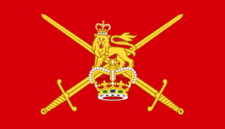Imperial Vionna-Frankenlischian Army
| Imperial Army | |
|---|---|
 | |
| Active | 1814 - 1946 |
| Disbanded | 1946 |
| Country | United Kingdom of Vionna-Frankenlisch |
| Allegiance | United Kingdom of Vionna-Frankenlisch |
| Nickname(s) | The Greybacks |
| Motto(s) | To do, To die |
| March | Queen Caroline March |
| Equipment | Equipment of the Vionna-Frankenlischian Army |
| Commanders | |
| First Commander | Field Marshall Sir Richard Walton |
| Last Commander | Field Marshall Viscount Winters |
The Imperial Army of Vionna-Frankenlisch was the offical Ground Forces branch of the Imperial Military of Vionna-Frankenlisch from 1815, the Imperial Military's formation, to September 1946 when it was split into the Imperial Vionnan Army, the Frankenlisch Defence Force and CFVF (Commonwealth Forces Vionna-Frankenlisch). It was commanded originally by Sir Richard Walton who had formerly served as commander of the Royal Frankenlischian Army. Its final commander before the dissolution of the unit was Viscount Winters who led the IVFA since 1940 and had proved a competent and well-organised leader throughout the Second Europan War, following this appointment he was made commanding officer of the new FDF but retired the next year.
At its peak, during 1916, the Imperial Army had 6,810,000 men at its command including Colonial forces. Throughout the force's 132 years of existence, conscription was enforced for only 22 of them.
History
Army of King Edward I
Following the early downfall of the Frankenlischian First Republic and the crowning of King Edward I Turrell, the new United Kingdom saw many external threats come to fruition and a national militia was formed. Each settlement in Vionna-Frankenlisch was required to maintain a standing force of militiamen proportional to the population of the settlement. There were no laws as to who could serve in this militia, provided they were between the ages of twelve and sixty, as a result, this force was often bolstered in strength by women, children and older men. This militia was required to muster for the local lord's inspection once a month and every four months there was a muster for the entire Earldom, further, there was a yearly muster in the winter for an inspection by the Dukes and Royals. In times of war, these militias were required to serve up to ten months at a time and, due to the heavy fighting following Vionna-Frankenlisch's formation, there are examples of these militia forces being both an effective fighting force and an incompetent mob. The Battles of Aachren and Dalârnas are respective examples.
Local Lords were originally responsible for the arming of these militias but following the 1821 Royal Muster where almost 20% of militiamen paraded without ranged weaponry and 50% without firearms this was overturned and the 1822 Model Carbine Musket was produced to arm the militias with. As Vionna-Frankenlisch expanded over the next two decades, these militias began to become insufficient to provide the bulk of the Vionna-Frankenlischian forces and as time went on more and more mercenaries and noble retainers were required to bolster the Vionna-Frankenlischian armies. This force was, from 1814, officially named and organised as the Imperial Vionna-Frankenlischian Army, despite its nature and appearance.
Army of King Edward II
This cobbled-together force of militia, noble retainers and multinational mercenaries was the Army of Vionna-Frankenlisch that King Edward II inherited in 1838 upon his father's death. It numbered a total of 330,000 according to records discovered in the wine cellar of Frankenlisch Castle and it appears that the militia received their uniforms and were armed with the new muskets only in the last year of Edward I's reign. It is clear to see that this situation didn't please Edward II who had fought in many of his father's campaigns as he immediately paid off the mercenaries, which made up an impressive 20% of the army, and called a muster, ordering every militiaman from every settlement to Frankenlisch where he held a grand review at Frankenlisch Castle. A parade was held through the streets of the city and the young King surveyed his men with a scrutinising eye and what he saw did not impress him.
According to council records, King Edward immediately proposed the disbanding of the militia forces and the establishment of a new standing army. He saw heavy resistance to these proposals and in the end agreed to a compromise. The militia would stay but a standing army would be put in its place as Vionna-Frankenlisch's main fighting force on land based on the old Frankenlischian Royal Army and its system of battalions and brigades rather than the Vionnan Empire's divisional model which was based on larger units. This standing army was formed from militia volunteers in 1841 and had 20,000 troops in 1845, this poor growth was met with propaganda campaigns and a four-month period of drafts as King Edward II wished to expand Vionna-Frankenlischian influence in Europa, through force if necessary.
By 1850, when the War of the Vionnan Coalition broke out, the Army had 90,000 men and the militia comprised of 290,000 men. The militiamen on the border provinces were mobilised into an "Army of Vionna" while the 90 thousand standing soldiers were organised into the First, Second and Third Corps of 30,000 men each. The militia were mainly used as reserves and were mobilised in numbers of around 100,000 but in some cases, specifically the Battle of Glaenarm, they performed admirably on the battlefield as frontline troops. This war taught the new Vionna-Frankenlischian commanders and politicians many lessons about contemporary warfare and a long period of military reforms followed until 1857 headed mainly by Sir James Jackson, Minister of War and Samuel Featherwick, Chief Secretary for War.